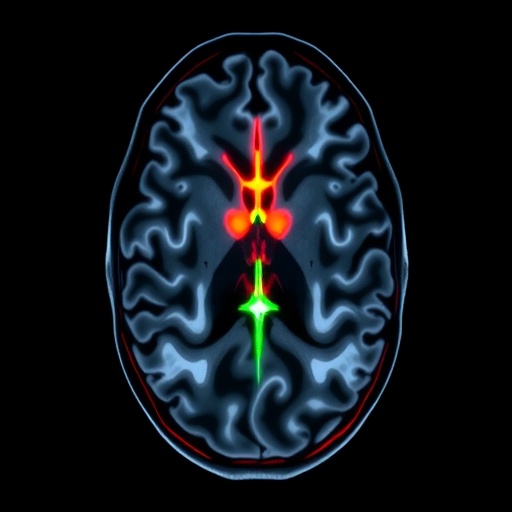In an unprecedented breakthrough at the intersection of artificial intelligence and biomedical engineering, researchers have developed a Convolutional Neural Network (CNN) autoencoder that exhibits remarkable prowess in interpreting the complex geometry of lumbar spine intervertebral discs. This innovative technology leverages the intricate details captured in segmented MRI scans, encouraging a new realm of understanding in spinal health diagnostics and treatment planning. By utilizing advanced machine learning techniques, the approach promises to enhance the accuracy and efficiency of analyses traditionally reliant on time-consuming manual assessments.
The primary objective of this research is to exploit the latent geometric patterns hidden in MRI data of the human lumbar spine. The study presents an expansive framework where the CNN autoencoder is designed not only to reconstruct input images but also to learn the underlying features that characterize spinal disc morphology. The autoencoder’s ability to compress information and reconstruct high-dimensional data into a manageable latent space is revolutionary as it can reveal meaningful physical and biological insights pertaining to spine health.
Intervertebral discs have a crucial role in the human body, acting as shock absorbers between the vertebrae and enabling motion while providing stability to the spine. However, degenerative changes in these discs can lead to debilitating conditions, such as chronic back pain and reduced mobility. Spinal disorders impact millions globally, and early and accurate diagnosis is paramount for effective intervention. Traditional imaging techniques, while informative, often fail to capture the nuances of disc geometry, particularly in asymptomatic individuals or subtle pathological cases. Consequently, there exists a significant need for techniques that can provide clearer insights, paving the way for personalized treatment approaches.
The methodology employed in this research hinges on a multi-step process of data acquisition, preprocessing, model training, and evaluation. Imaging data was acquired from numerous patients, ensuring a rich dataset encompassing a variety of spinal morphologies and pathologies. Following image segmentation, the datasets underwent rigorous preprocessing to enhance features pertinent to the model’s training phase. The CNN architecture was then meticulously crafted, emphasizing both the encoding and decoding pathways to consistently produce high-fidelity reconstructions of the original MRIs.
Deep learning, particularly through CNNs, entails the training of multilayer neural networks capable of distinguishing intricate patterns in large datasets. In this case, the layers of the autoencoder worked together to abstract and learn multi-level representations of spinal structures, ultimately leading to a salient encoding of the disc geometries. The training phase utilized a combination of supervised learning techniques, whereby the model learned from labeled data, and unsupervised learning, where it identified patterns within unlabeled datasets, augmenting its understanding of the geometries it was designed to interpret.
One of the most compelling aspects of this research lies in the validation of the model’s performance against traditional diagnostic standards. By benchmarking the CNN autoencoder’s accuracy in comparison to expert radiologists’ assessments, the study reveals a promising trend where the neural network rivals human expertise in identifying and characterizing disc abnormalities. This revelation serves not only to validate the methodology but also to suggest a potential shift in how spine diagnostics could be approached in clinical practice.
Furthermore, the potential applications of this research extend beyond diagnostic imaging. By mapping the latent space of spinal disc geometries, the technology could inform predictive models that anticipate the progression of spinal disorders based on observed geometrical transformations. Such predictive analytics could revolutionize proactive care pathways, allowing for tailored treatment plans that consider individual patient morphology and specific health trajectories.
However, discussions surrounding the ethical implications of utilizing AI in medicine cannot be overlooked. Ensuring that these technologies augment rather than replace human expertise is of utmost importance. Ongoing training, transparency in AI decision-making processes, and validation against real-world clinical outcomes will be essential to effectively integrate these tools within existing healthcare frameworks.
The findings from this research not only showcase the technical capabilities of CNNs in image processing but also highlight the transformative potential of combining artificial intelligence with practical healthcare needs. As we move deeper into the age of data-driven medicine, the implications of such studies could pave the way for exploring other anatomical structures, potentially impacting other fields of research and diagnostics.
Revolutionizing medical imaging with AI-driven insights could therefore expand beyond spinal health, opening avenues for improved understanding of various conditions affecting human anatomy. Each step forward in this domain brings with it the promise of enhanced patient care—rapid diagnostics, tailored interventions, and ultimately, a higher quality of life for individuals suffering from spinal ailments.
In conclusion, the development of a CNN autoencoder specifically designed to learn and interpret the latent geometries of lumbar spine discs signifies a landmark advancement in biomedical engineering. As researchers continue to unravel the complexities of bodily structures with the aid of artificial intelligence, one cannot help but anticipate a rapidly evolving healthcare landscape where technology and human ingenuity coalesce to transform patient diagnostics and treatment protocols.
This significant endeavor, with its promise of bridging the gap between intricate anatomical data and clinical application, sets a precedent for future research in medical imaging. With continued dedication, this fusion of AI and biomedical engineering could herald a new era in which personalized, precise, and proactive treatment becomes the standard, driving improved outcomes for individuals plagued by spinal disorders and beyond.
Subject of Research: Development of a CNN Autoencoder for Spinal Disc Geometry Interpretation from MRI
Article Title: A CNN Autoencoder for Learning Latent Disc Geometry from Segmented Lumbar Spine MRI
Article References:
Perrone, M., Moore, D.M., Ukeba, D. et al. A CNN Autoencoder for Learning Latent Disc Geometry from Segmented Lumbar Spine MRI. Ann Biomed Eng (2025). https://doi.org/10.1007/s10439-025-03840-w
Image Credits: AI Generated
DOI:
Keywords: Artificial Intelligence, CNN Autoencoder, Lumbar Spine, MRI, Intervertebral Disc, Medical Imaging, Biomedical Engineering, Machine Learning, Predictive Analytics, Patient Care
Tags: advanced imaging techniquesartificial intelligence in healthcareautomated MRI interpretationbiomedical engineering innovationsCNN autoencoder technologydegenerative disc disease assessmenthealthcare data compression methodsintervertebral disc diagnosticslumbar spine MRI analysismachine learning for spinal healthneural networks in medical imagingspinal disc morphology analysis





